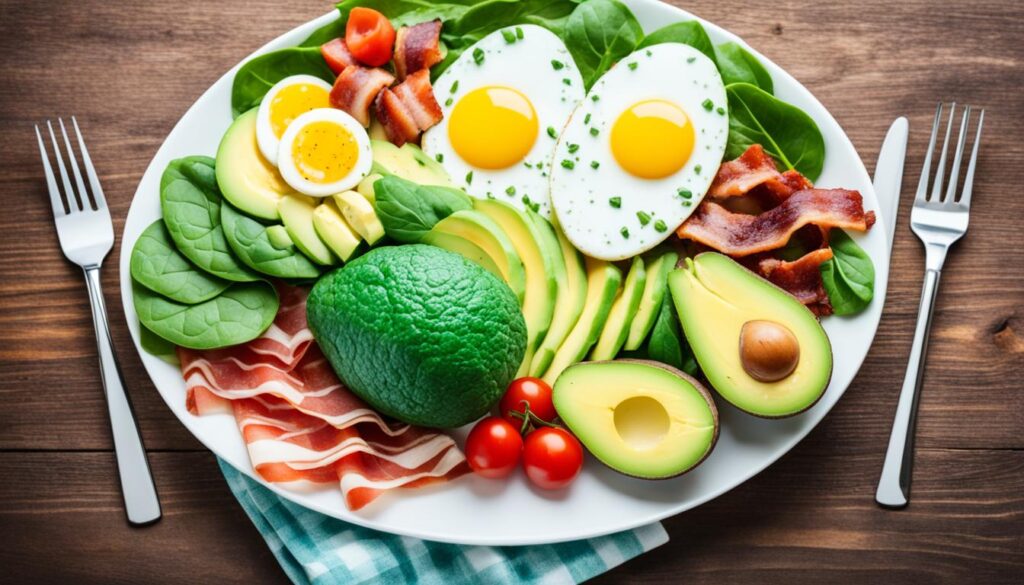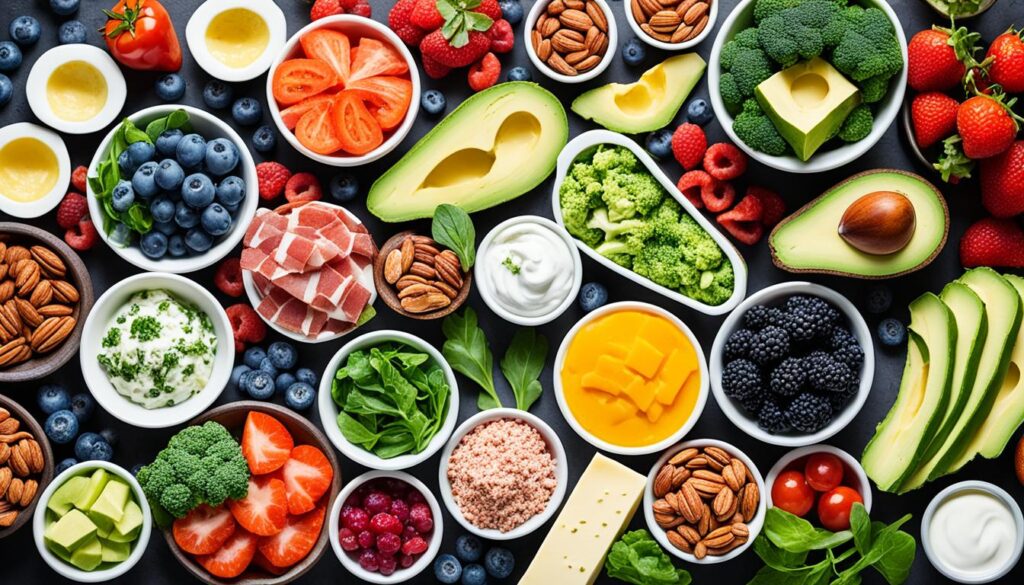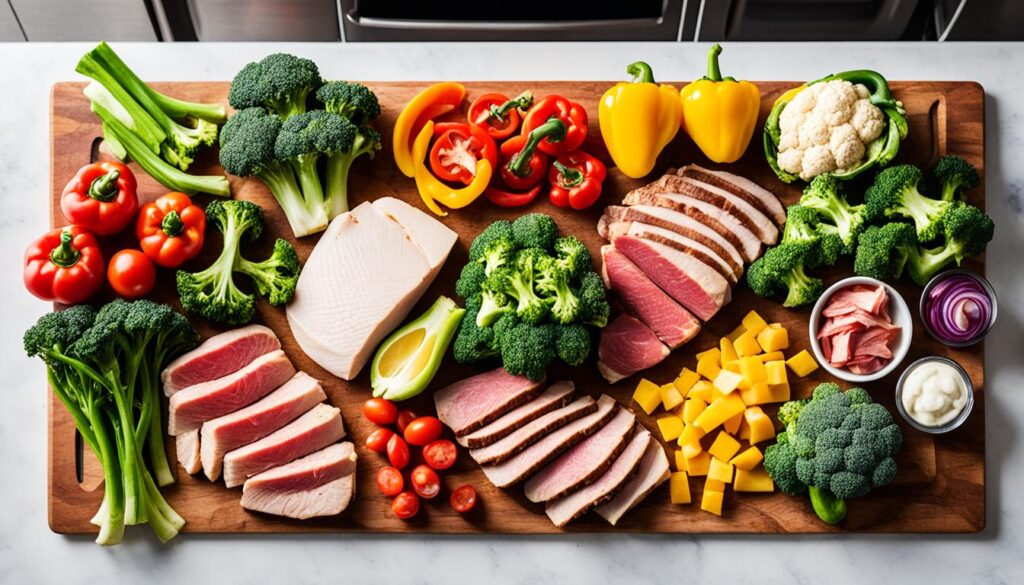Imagine a diet that lets you enjoy rich, creamy foods while losing weight. Welcome to the keto diet, a new way to live low-carb that’s caught the eye of health lovers and those watching their weight. But what is this ketogenic lifestyle, and how can it change your health and happiness? Get ready for a journey as we share the secrets of the keto diet and its benefits for your body and mind.

Key Takeaways
- The keto diet is a low-carb, high-fat eating plan that puts your body into a fat-burning state known as ketosis.
- Potential benefits of the keto diet include weight loss, improved metabolic health, and increased energy levels.
- To achieve ketosis, you’ll need to drastically reduce your carb intake and focus on consuming healthy fats, protein, and low-carb vegetables.
- Meal planning and incorporating nutrient-dense keto-friendly foods are essential for success on the keto diet.
- Combining the keto diet with intermittent fasting can further enhance the weight loss and metabolic benefits.
Understanding the Keto Diet
The keto diet, also known as the “keto diet,” focuses on high fat, moderate protein, and low carbs. This diet makes the body enter a state called ketosis. In this state, fat becomes the main energy source instead of glucose.
What is a Ketogenic Diet?
This diet changes the body’s energy source from carbs to fat and ketones. To do this, carbs are cut down to less than 50 grams a day. The liver then makes ketones, which the body and brain use for energy.
Benefits of a Low-Carb Lifestyle
- Promotes weight loss by increasing fat-burning
- Improves insulin sensitivity and blood sugar control
- Enhances cognitive function and mental clarity
- Reduces inflammation and may benefit certain medical conditions
- Provides a steady source of energy without the blood sugar spikes and crashes associated with a high-carb diet
Learning about the keto diet and its benefits can help people decide if a low-carb lifestyle is right for them. It can lead to a fat-burning state and ketosis.
“The ketogenic diet is a powerful tool for weight loss, improved health, and better energy levels. By shifting the body’s primary fuel source from carbs to fat, you can experience a variety of benefits that can have a profound impact on your overall well-being.”
Keto Diet and Weight Loss
The keto diet is popular because it helps with weight loss. It’s a high-fat, low-carb diet that puts your body into a ketosis state. In this state, your body uses fat for energy instead of glucose.
Entering a Fat-Burning State
By eating fewer carbs, your body starts using fat for fuel instead of glucose. This is called ketosis. It helps your body burn fat for energy, which leads to fat loss.
Getting into ketosis can take a few days to weeks. It depends on many factors. While your body changes, it learns to use the keto diet and become great at fat-burning.
- Reducing carbs makes your body enter ketosis.
- In ketosis, your body uses fat for fuel instead of glucose.
- This state can cause significant and lasting weight loss.
Understanding how the fat-burning state works and how to stay in ketosis helps you use the keto diet for weight management.
Achieving Ketosis
Reaching and keeping a state of ketosis is key to the keto diet’s benefits. This state makes your body burn fat for energy, not carbs. It helps with weight loss, boosts energy, and improves your brain function.
To get and keep ketosis, follow these steps:
- Limit your carb intake: Keep your daily carbs to 20-50 grams or less. This makes your body use fat for energy instead of carbs.
- Check your ketone levels: Use tests like urine, blood, or breath analyzers to see if you’re in ketosis. Aim for levels between 0.5 to 3.0 millimoles per liter (mmol/L).
- Adjust as needed: If your ketone levels aren’t right, tweak your diet. You might eat fewer carbs, eat more fat, or try fasting.
By doing these steps and watching your progress, you can enter and stay in ketosis. This unlocks the keto diet’s health benefits.
| Ketosis Indicators | Optimal Range |
|---|---|
| Blood Ketones | 0.5 – 3.0 mmol/L |
| Urine Ketones | Moderate to High |
| Breath Ketones | 10 – 40 ppm |
Getting and keeping ketosis is vital for the keto diet‘s benefits. By watching your progress and adjusting as needed, you keep your body in a fat-burning state. This helps with weight loss and better health.
Nutrient-Dense Keto Foods
Starting a keto diet means eating foods high in fat that help your body burn fat. Foods like avocados, nuts, and olive oil are key for a keto lifestyle.
High-Fat Foods to Embrace
Choosing the right high-fat foods is key for staying in ketosis. Great choices include:
- Avocados – Full of healthy fats, fiber, and vitamins and minerals.
- Nuts and seeds – Almonds, walnuts, pecans, and chia seeds offer essential fats and nutrients.
- Olive oil – A cooking oil rich in anti-inflammatory oleic acid.
- Fatty fish – Salmon, mackerel, and sardines are great for omega-3 fatty acids.
- Coconut oil – Contains MCTs that help with ketosis.
Low-Carb Veggies and Fruits
The keto diet focuses on high-fat and low-carb foods. Yet, you can still enjoy low-carb vegetables and some low-carb fruits. Great choices are:
- Leafy greens – Spinach, kale, and arugula are packed with nutrients and low in carbs.
- Cruciferous veggies – Broccoli, cauliflower, and Brussels sprouts are fiber-rich and low in carbs.
- Berries – Raspberries, blackberries, and blueberries are high in fiber and low in sugar.
- Citrus fruits – Lemon and lime add a refreshing touch to keto meals and drinks.
Adding these high-fat and low-carb foods to your keto diet nourishes your body. It also helps you enjoy the benefits of a fat-burning lifestyle.

“The key to success on the keto diet is to focus on filling your plate with a variety of nutrient-dense foods that are low in carbs and high in healthy fats.”
Keto Diet Meal Planning
Planning your meals is key to doing well on the keto diet. By planning your ketogenic meals carefully, you can keep your body in fat-burning mode. Plus, you’ll get to enjoy a mix of tasty and healthy foods.
Creating a Well-Rounded Meal Plan
To make a keto diet meal plan that helps you stay healthy and lose weight, try these tips:
- Use lots of healthy fats like avocado, olive oil, nuts, and seeds. Also, pick low-carb veggies such as leafy greens, broccoli, and cauliflower.
- Make sure to eat plenty of protein. Choose from grass-fed meats, poultry, fish, and eggs to stay full and satisfied.
- Keep an eye on your food’s balance. Aim for a keto diet mix of about 70% fat, 20% protein, and 10% carbs.
- Try intermittent fasting with your keto diet to boost fat-burning and get more health perks.
- Try out different ketogenic meals to keep your meals interesting and avoid getting bored.
With these tips, you can make a balanced keto diet meal plan. This will help you reach your health and fitness goals.
| Keto-Friendly Breakfast | Keto-Friendly Lunch | Keto-Friendly Dinner |
|---|---|---|
| Scrambled eggs with avocado and bacon | Grilled salmon with roasted broccoli and olive oil | Zucchini noodles with creamy pesto and grilled chicken |
| Bulletproof coffee with MCT oil | Spinach salad with grilled steak, feta, and avocado | Baked stuffed portobello mushrooms with ground beef and cheese |
| Chia pudding with berries and coconut cream | Tuna salad wrapped in lettuce leaves | Spaghetti squash with meatballs and marinara sauce |
By using these tips and trying out different ketogenic meals, you can make a meal plan that’s both healthy and tasty. This will support your health and fitness goals.
High-Fat Keto Recipes
Embracing the keto diet opens up a new world of tasty and fulfilling meals. You’ll find everything from creamy dips to juicy meats. These high-fat recipes are perfect for your ketogenic meals. They’ll make your taste buds dance and help you stick to your low-carb plan.
Creamy Avocado Dip
Avocados are key in the keto diet, full of healthy fats. This creamy dip is great with veggie sticks or pork rinds. It’s a guilt-free snack or appetizer for your ketogenic meals.
Juicy Steak with Roasted Vegetables
This steak dish is packed with protein and healthy fats. It comes with roasted low-carb veggies. This high-fat recipe is the perfect keto diet main course. It’ll keep you full and energized.
| Keto-Friendly Recipes | Nutritional Information (per serving) |
|---|---|
| Creamy Avocado Dip | Calories: 250, Total Fat: 22g, Carbs: 8g, Protein: 4g |
| Juicy Steak with Roasted Vegetables | Calories: 400, Total Fat: 28g, Carbs: 12g, Protein: 32g |
Discover the many high-fat recipes for the keto diet. They open up a world of tasty and fulfilling ketogenic meals. With these options, you won’t miss out on flavor on your low-carb journey.

Keto Diet
The keto diet is more than a way to lose weight. It’s a low-carb lifestyle that boosts your health and well-being. It’s a powerful tool for long-term wellness.
The keto diet improves your metabolic function. It puts your body into a state of ketosis. This helps control blood sugar, improve insulin sensitivity, and balance hormone levels. You’ll notice better energy, less inflammation, and a more stable mood.
The keto diet also boosts your brain power. By using fat as main fuel, it enhances mental clarity, focus, and memory. This diet is great for those wanting to improve their brain health and cognitive skills.
For long-term weight management, the keto diet is a great choice. It helps control appetite, reduces cravings, and keeps your metabolism healthy. This is especially helpful for those who’ve had trouble with weight stability in the past.
“The keto diet has the potential to transform not just your waistline, but your overall metabolic health and well-being.”
Starting the keto diet is about more than losing weight quickly. It’s a lifestyle that offers many health benefits. By going low-carb, you can improve your health and quality of life for years.
Intermittent Fasting and Keto
For those looking to boost their health and manage weight on the keto diet, adding intermittent fasting can be a great choice. This combo brings together two strong methods to help burn fat, make insulin more effective, and boost metabolic health.
Combining Two Powerful Approaches
The keto diet focuses on eating low-carb, high-fat foods. This puts your body into ketosis, where it uses fat as its main energy source. Intermittent fasting adds to this by alternating eating and fasting periods. Together, they create a powerful mix that speeds up weight loss, improves insulin use, and boosts overall health.
By planning your meals and fasting at the right times, you can make the most of the keto diet. This approach helps your body easily switch between burning fat and being in ketosis. It not only helps with weight control but also offers more health perks like better brain function, less inflammation, and stable blood sugar levels.
FAQ
What is the ketogenic (keto) diet?
The ketogenic diet is a plan that focuses on high-fat, moderate-protein, and low-carb foods. It helps the body enter a state called ketosis. In this state, the body uses fat for energy instead of glucose from carbs.
What are the benefits of following a low-carb, keto lifestyle?
Following the keto diet can lead to weight loss and better insulin sensitivity. It may also improve cognitive function, blood sugar control, and energy levels. The diet is being studied for its benefits in type 2 diabetes, epilepsy, and some neurological disorders.
How does the keto diet help with weight loss?
The keto diet helps with weight loss by making the body burn fat for energy instead of glucose. By cutting down on carbs, the body uses fat as its main fuel. This can lead to fewer calories consumed and more fat burned, resulting in weight loss.
How do I achieve and maintain ketosis?
To be in ketosis, you need to eat fewer than 50 grams of carbs a day. This makes your body use fat for energy. You can check if you’re in ketosis with urine, blood, or breath tests.
What are the best keto-friendly foods to eat?
Good keto foods include avocados, nuts, olive oil, fatty fish, eggs, and low-carb veggies like leafy greens and broccoli. Avoid high-carb foods like grains and most fruits.
How do I create a well-rounded keto meal plan?
Plan your meals with a mix of high-fat, moderate-protein, and low-carb foods. Think about dishes like grilled salmon with broccoli and butter, or a spinach salad with avocado dressing. Having keto snacks ready can also help you stick to the diet.
Can the keto diet be combined with intermittent fasting for additional benefits?
Yes, pairing the keto diet with intermittent fasting can boost fat burning and metabolic health. Intermittent fasting means eating and fasting in cycles. When done with a keto diet, it helps the body burn more fat.
